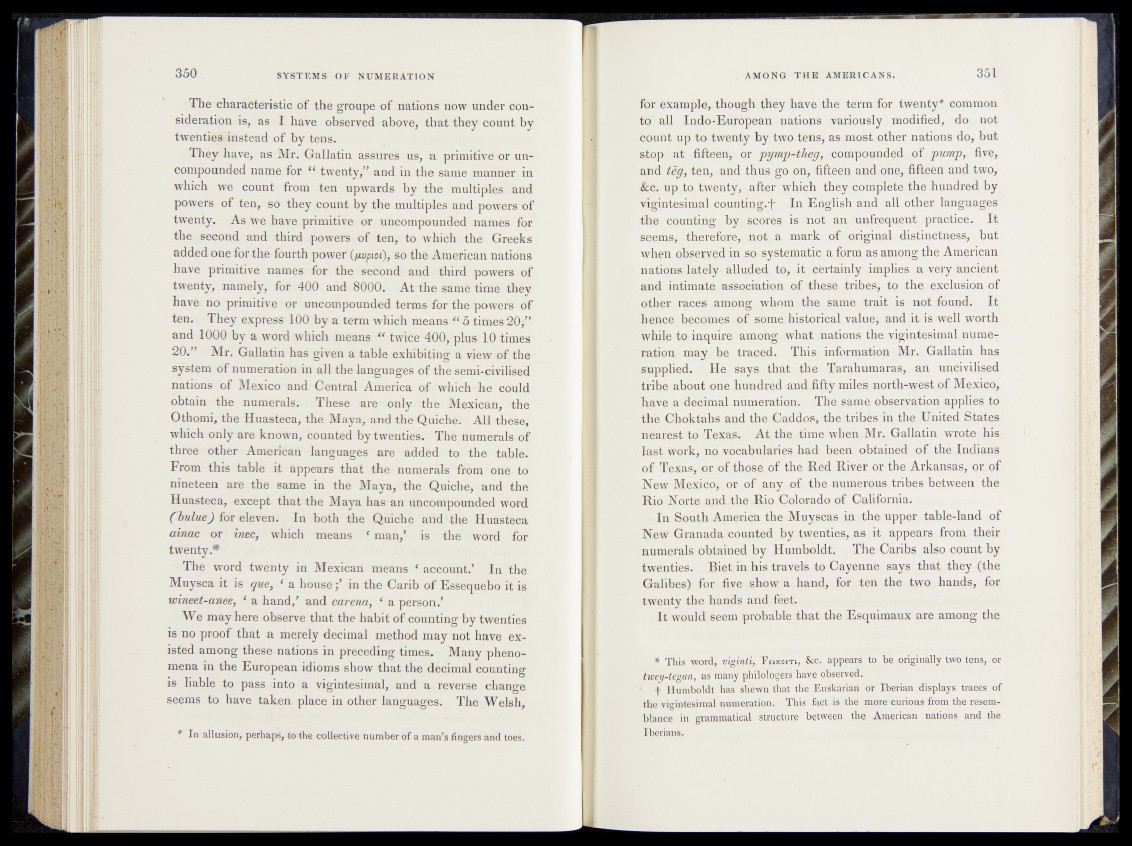
The characteristic of the groupe of nations now under consideration
is, as I have observed above* that they count by
twenties instead of by tens.
They have, as Mr. Gallatin assures us, a primitive or uncompounded
name for “ twenty,” and in the same manner in
which we count from tea upwards by the multiples and
powers of ten, so they count by the multiples and powers of
twenty. As we have primitive or uncompounded names for
the second and third powers of ten, to which the Greeks
added one for the fourth power (pivpioi), so the American nations
have primitive names for the second and third powers of
twenty, namely, for 400 and 8000. At the same time they
have no primitive or uncom pounded terms for the powers of
ten. They express 100 by a term which means *i:S
and 1000 by a word which means “ twice 400, plus 10 times
20.” Mr. Gallatin has given a table exhabking a view of the
system of numeration in all the languages of the semi-civilised
nations of Mexico and Central America of which he could
obtain the numerals. These are only the Mexican, the
Othomi, the Huasteca, the Maya, and the Quiche. All these*;
which only are known, counted by twenties. The numerals of
three other American languages are added to the table.
From this table it appears that the numerals from one to
nineteen are the same in the Maya, the Quiche, and the
Huasteca, except that the Maya has an uncom pounded word
(bulue) for eleven. In both the Quiche andvthe Huasteca
avrmc or inec, which means I man/ is the word for
twenty..*
The word twenty in Mexican means ‘ account.’ In the
Muysca it is que, ‘ a house ft in the Carib of Essequebo it is
wineet-anee, t? a hand/ and carena, ‘ a person.’
We may here observe that the habit of counting by twenties
is no proof that a merely decimal method may not have existed
among these nations in preceding times. Many phenomena
in the European idioms show that the decimal counting
is liable to pass into a vigintesimal, and a reverse change
seems to have taken place in other languages. The Welsh,
* In allusion, perhaps, to ‘the collective number of a man’s (fingers and toes.
for example,-though they Jwtve the term for twenty* common
to all Indo-European nations variously modified, do not
count up to twenty by two tens, as most other nations do, but
stop at fifteen, or pgmp-tbeg, compounded of puwtp, five,
and tftg-f and .thus^go^pn, fifteen and one, fifteen and two,
See. up-to twenty, after wnijph they complete the hundred by
vigintesimal^cguntipig^ In English and ,,all other languages,
the counting,, by.rscores is -not, an^uufEe<^uen%pfactioe. It
sp^uj^^therefore,.. not a mark of original distinctness,,/but
when observed in so systematic a farm as ampngitbe/American
nations lately alluded to, it certainly implies., a ,ve?;y undent .
of these tribes, tQNthe, j^gpkisi©tt of
olifelr races amona: whom^the (same trait , is pot. found. It
hence becomes ©f some historical value, and it? is well worth
while -to inquire; among what «nations, the vigintesimal numeration
may/be. traced. This information Mr.' Gallatin has
supplied» : ' He says that the Tarahumm^gkan uncivilised
tribe about one hundred and fifty miles nortb-\p©$t of Mexico*,
have a decimal numeration. The.same observation applies to
the Choktahs- and the Caddos, the tribes in the United gate's
r^swat to Texas» At the time when Mr*,Gallatin wrote his
last work, fao vocabularies had been o b ta in ed ^ ' the Indians
of Texas, or of those of the Red River or the Arkansas, or of
New Mexico,- or of any^of ,the numerous tribes, between the
Rio Norte and the-Rio 'Colorado of G^ifopnia.
In South America the Muyscas in the upper table-land af
New Granada counted by twenties* as it appears from their
numerals obtained by Humboldt. . The Caribs also count by
twenties. Biet in bis travels to Cayenne says that.jthfey.sCthe
Galibes) for five show a hand, for ten the two hands, ;%r
twenty the hands and feet.
I t would Seem .probable that the Esquimaux arC ajnG^g the
* This word, v ig in ti, Fsutom, &c. appears to be-originally two tens; or
iw e y -te g a n , as many philöiöfjers nave Observed* “
1 + Humboldt has shewn -that ttfê Eu’skarian or Ibérian displays traces of
the >V'igintèsimal numeration, This fa s tis , the more curious from the -resemblance
in grammatical struct Me' between the, America® nations and the
Iberians.